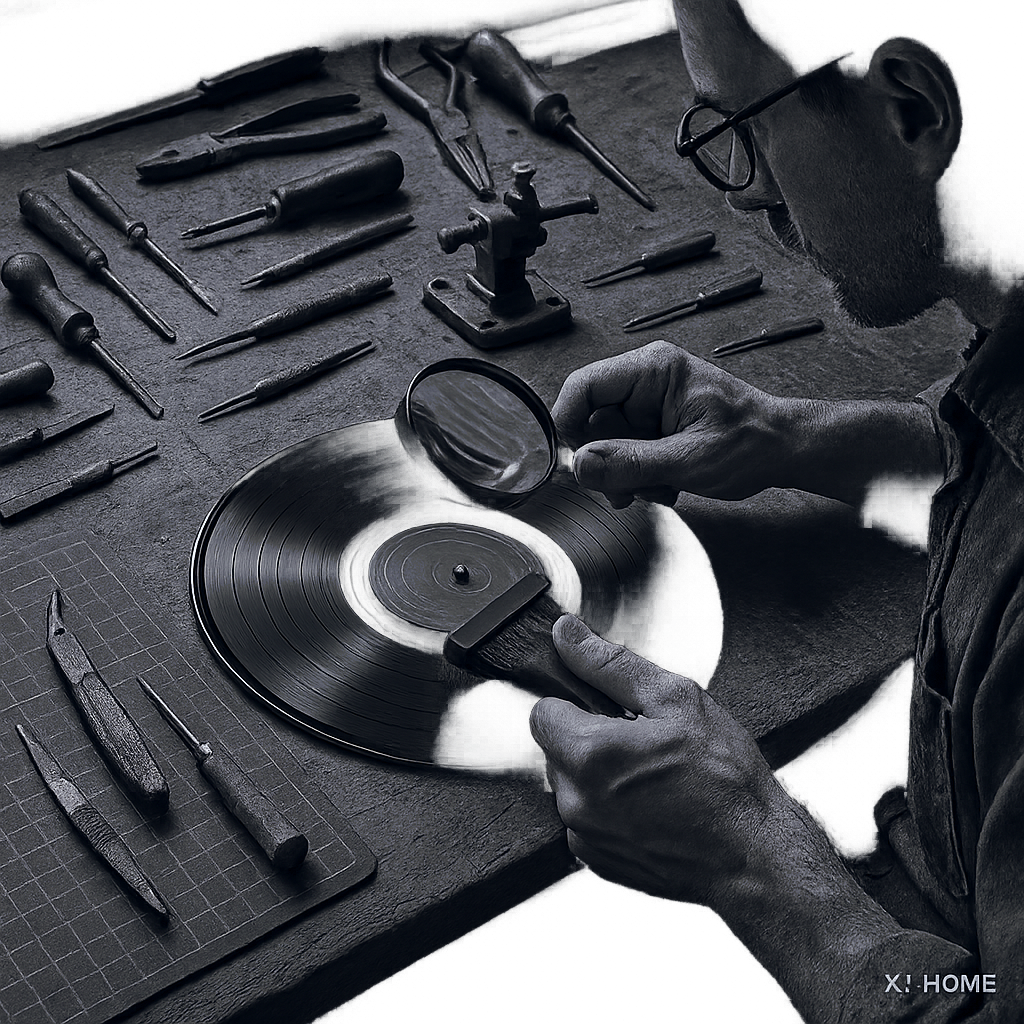The turntable belt. It might seem like one of the simplest components in your analog rig, a mere rubber band tasked with spinning your platter. But for those of us who chase the dragon of analog purity, this unassuming loop is a critical juncture where motor vibrations can be tamed, and speed stability can be won or lost. The choice of belt type – and indeed, its material and condition – is more than a trivial detail; it's a foundational element in the complex dance that extracts music from a vinyl groove.
Many discussions dead-end at a simple comparison of flat versus round belts. But let's be honest, the audiophile world is rarely that simple, and "common wisdom" often masks a more intricate reality. If you're looking to truly understand how to choose, or even just appreciate the engineering involved, we need to dig deeper, challenging a few assumptions along the way.
The Usual Suspects: Belt Profiles and Their Raison d'être
At its core, a turntable belt is an elastomer band that transmits rotational force from the motor to the platter. The goal is smooth, consistent speed with minimal interference. The two most common profiles you'll encounter are:
-
Flat Belts: These are the workhorses of the turntable world, and for good reason. A flat belt typically rides on the crowned surface of a motor pulley and the outer rim of the platter (or sub-platter).
-
Why they're prevalent: Flat belts offer a relatively large contact area, which can translate to excellent grip and efficient torque transfer, especially with heavier platters. The width allows for distribution of stress and can contribute to longevity. From an engineering standpoint, achieving precise flat belt dimensions and consistent material properties is a well-understood manufacturing process.
-
The First Principles Angle: The effectiveness of a flat belt hinges on its elasticity, the coefficient of friction between the belt and the pulley/platter, and consistent thickness. Any variation in thickness can introduce minute speed variations (wow and flutter).
-
-
Round Belts: Often seen in specific turntable designs, particularly some European makes or more minimalist constructions. These typically run in grooved pulleys and sometimes a grooved platter edge.
-
Why they're chosen: A round belt in a V-groove pulley has a self-centering tendency, which can be advantageous in some designs by simplifying alignment. The contact area is smaller and more concentrated than a flat belt. Some designers argue this can lead to less transmission of motor noise if the belt material has the right damping properties.
-
The First Principles Angle: With round belts, the precision of the groove in both the motor pulley and the platter is paramount. The belt's diameter and its durometer (hardness) are critical for proper tension and grip without excessive stretching or slippage.
-
You might occasionally encounter square-section belts or even fabric/thread-based belts (like those used by some vintage Garrard or Lenco idler-drive turntables, though that's a different drive mechanism principle). For the purpose of modern belt-drive systems, flat and round are the main players.
Engineering Trade-Offs: Where the Rubber Meets the (Sonic) Road
Choosing a belt isn't just about fit; it's about understanding the inherent engineering trade-offs and how they impact the sound.
1. Speed Stability (Wow & Flutter): The Unwavering Spin
This is paramount. Any inconsistency in speed translates directly into audible pitch variations.
-
Flat Belts: Their wider contact patch can offer superior grip and stability, especially if the belt is of high quality and precisely ground. However, this also means that any imperfections in the belt's surface or thickness are more likely to be "felt" by the platter. The material's ability to maintain its elasticity over time is crucial.
-
Round Belts: The smaller contact area might seem like a disadvantage, but in a well-designed grooved system, it can provide very stable drive. The key is the precision of the pulley grooves and the belt's consistency. Some argue that round belts can be more forgiving of minute motor cogging due to their profile and the way they engage the pulley.
-
The Blind Spot/Iconoclastic Thought: Is "maximum grip" always the goal? Not necessarily. A belt also needs to be compliant enough to absorb motor vibrations. Too much grip, with a non-compliant material, might transfer more unwanted energy. It's a balancing act. Furthermore, the motor itself and its control circuitry are arguably more critical for initial speed stability than the belt type alone. The belt's job is to faithfully transmit that stability and isolate what it can.
2. Noise Isolation (Rumble): Silence is Golden
The belt is your first line of defense against motor noise (rumble) reaching the platter and, ultimately, your stylus.
-
Material is King (and Queen, and the entire Royal Court): This is where the specific elastomer compound (Neoprene, EPDM, Silicone, proprietary blends) truly shines or falters. A material with good damping properties will absorb vibrations rather than transmitting them.
-
Neoprene: Common, good all-arounder, decent damping.
-
EPDM (Ethylene Propylene Diene Monomer): Excellent resistance to ozone, UV, and aging. Can offer good damping.
-
Silicone: Can offer very high damping but may also stretch more or have different friction characteristics. Often found in "upgrade" belts.
-
-
Profile Influence: Some argue that the smaller contact patch of a round belt, combined with the right material, might transmit less noise. Others contend a well-damped flat belt can be equally effective or better due to its broader surface for energy dissipation. The truth is, it's highly dependent on the specific implementation – the motor, its mounting, the platter mass, and the belt itself.
-
XJ-HOME Connection: Just as we at XJ-HOME believe that true high-fidelity playback is a sum of meticulously engineered parts working in harmony, the humble belt is no exception. Understanding its role in vibration damping is key to unlocking the full potential of your system – a philosophy we champion when curating equipment for xenonjade.com. The pursuit of sonic purity means sweating these details.
3. Durability, Longevity, and the Creep Factor
A belt is a wear item. It stretches, it hardens, it cracks.
-
Flat belts, due to their larger mass, may offer longer lifespans under ideal conditions, but they are also subject to stretching and glazing.
-
Round belts can also stretch, and if the material isn't top-notch, they can develop flat spots or lose their precise circular profile.
-
The "Creep" Factor: All elastomer belts will stretch slightly under tension over time (a phenomenon known as creep). This can lead to speed inaccuracies. Regular replacement (every 2-5 years, or as recommended by the turntable manufacturer) is good practice. For an accessible overview of elastomer properties, including creep, Wikipedia's page on Elastomers offers a good starting point.
The Collector's Conundrum & The Pragmatist's Path
So, how do you navigate this in the real world?
-
Originality vs. "Upgrade":
-
Stick with the Manufacturer's Spec (Usually): The turntable designer chose a specific belt type and material for a reason, based on their overall design philosophy and component matching. For 90% of users, the official replacement belt is the safest and often best bet. They've done the R&D.
-
The Aftermarket Allure: The audiophile world is rife with "upgrade" belts, often made from exotic materials or to tighter tolerances. Can they make a difference? Sometimes, yes. If your original belt was a compromise due to cost, a high-quality aftermarket belt might offer audible improvements in speed stability or lower perceived noise. But beware of placebo and exaggerated claims.
-
Human Nature Alert: We audiophiles love to tinker! The desire to extract that "last 5%" is strong. Just ensure your tinkering is informed.
-
-
Practical Considerations:
-
Availability & Cost: Some belts, especially for obscure or very high-end turntables, can be surprisingly expensive or hard to find.
-
Ease of Installation: Most are easy, but some turntables require minor disassembly.
-
Signs of Wear: Visible cracks, glazing (shiny surface), or if the belt feels too loose or too tight. If you have a strobe disc and can verify speed, that's the ultimate test.
-
-
The "Good Enough" Principle vs. Chasing Ghosts:
-
Let's be iconoclastic: At what point do belt differences become truly inaudible for your system and your ears? A $100 "cryo-treated, unicorn-hair-infused" belt on an entry-level turntable is unlikely to transform it. Conversely, a poorly made $5 belt on a high-precision deck can absolutely hamstring its performance. Context is everything. Don't let "audiophile nervosa" lead you down an expensive rabbit hole unless you have objective reasons (and ideally, measurements) to suspect your belt is a limiting factor.
-
Making YOUR Choice: A Framework, Not a Prescription
There's no single "best" belt type for all turntables. The optimal choice is a function of your specific deck, your priorities, and sometimes, your willingness to experiment.
-
Know Your Turntable: Research what the manufacturer recommends. Understand why they chose that belt type if possible (check forums, reviews, manufacturer literature). What was the original design intent?
-
Know Your Priorities: Is infinitesimal wow & flutter your holy grail? Or is ultra-low background noise more critical for your listening habits? What's your budget?
-
Trust Your Ears (But Verify): If you do experiment with a different belt type or material (e.g., switching from a stock neoprene flat belt to a silicone one, assuming correct dimensions), try to do A/B comparisons if possible, though this is hard with belts. Listen for changes in pitch stability (sustained piano notes are great for this), background noise, and overall clarity. A useful resource for understanding what you're listening for is the Wikipedia entry on Wow and flutter, which details these audible effects.
-
Don't Neglect the Basics: Ensure your motor pulley and platter edge are clean. Any oil, dust, or old rubber residue can compromise the belt's performance, regardless of its type.
The Unsung Conductor
The humble turntable belt, often overlooked, plays a vital role in the symphony of analog playback. It's a testament to the elegant engineering that underpins our beloved format. By understanding the forces at play and the nuances between different types and materials, you're better equipped to ensure this unsung conductor is leading your platter in perfect time, allowing the music to flow as the artists intended. It’s this attention to every detail, from the stylus to the belt, that defines the pursuit of high-fidelity sound – a passion we share and support at XJ-HOME.
Happy listening, and may your platters spin true.





Leave a comment
All comments are moderated before being published.
This site is protected by hCaptcha and the hCaptcha Privacy Policy and Terms of Service apply.